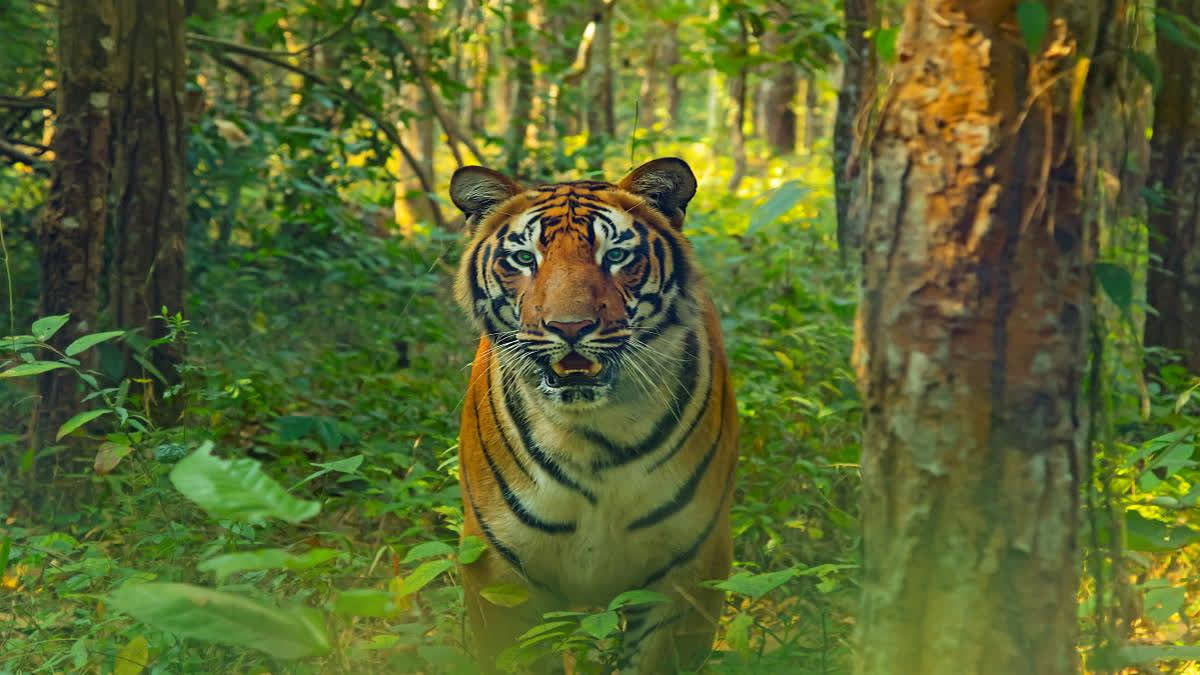Guwahati:A recent research has revealed that the number of Royal Bengal Tigers has increased threefold in western Assam's Manas National Park. A team of researchers from the prominent wildlife conservation and biodiversity organisation Aaranyak said that the tiger population in the Manas National Park is on an increasing trend and will grow to double its number within 2030 provided conservation measures are in place and effective.
The research highlighted a significant increase in tiger population density, rising from 1.06 adults per 100 km² in 2011–12 to 3.64 adults per 100 km² in 2018–19, with the potential for further growth to 8.0 or higher. In 2021, 44 adult tigers were recorded through photographic evidence in Manas National Park.
The research finding was published in the Journal of Biological Conservation, one of the highly regarded journals of biological sciences. The article was penned by Dipankar Lahkar, senior manager and researcher of Aaranyak and the other co-authors included M Firoz Ahmed, HoD, Tiger Research and Conservation Division of Aaranyak, Ramie H Begum, associate professor, Assam University (Diphu Campus), Sunit Kumar Das of WWF- India, Hiranya Kumar Sarma and Anindya Swargowari, former Park Managers-Manas Tiger Reserve, YV Jhala, former Professor and Dean at Wildlife Institute of India, Imran Samad, Independent Researcher and Abishek Harihar, Director-Tiger Programme of Panthera.
The development assumes significance because conservation in Manas National Park suffered during the middle of 1985 when civil unrest broke out in Bodoland areas where the Manas National Park was located over the demand for a separate state. This long period of ethnopolitical conflict had a significant impact on Manas National Park, as the park's management suffered tremendously for many years. During this phase, existing park establishments were devastated, and many forest officials were assassinated while on duty, completely disrupting the conservation efforts.
"Aside from illegal hunting, which drove the Rhino locally extinct, huge tree felling and encroachment irreversibly devastated a large portion of the park. The population of tigers and other large wild cats and herbivores was severely reduced and Manas was hoping for a new dawn to reclaim its lost treasure from the ashes" said Anindya Swargowari, a former Park Manager and retired Indian Forest Service officer.
"Manas National Park, part of the Transboundary Manas Conservation Area (TraMCA), along with Royal Manas National Park in Bhutan, represents a significant core habitat within the TraMCA landscape. These interconnected landscapes are crucial for biodiversity conservation, as evidenced by the remarkable recovery of the tiger population in Manas National Park. This impressive resurgence was achievable in a post-conflict context because of the extensive and interconnected forest areas in the Indo-Bhutan region," said M Firoz Ahmed, the team lead at Aaranyak.
The research further pointed out that the growth of the tiger population in the park is due to the effectiveness of enhanced conservation efforts by the Forest Department and other stakeholders. The growth was supported by thriving tourism revenue, which bolstered management budgets. The findings of the research also indicate that collaborative efforts from local communities, government and conservation agencies can lead to successful species recovery in post-conflict scenarios. However, challenges like poaching and habitat loss persist, emphasising the need for continuous management focus as the tiger population approaches their carrying capacity.
“I feel privileged to have served as the Field Director of Manas from 2015 to 2019 and during that period I witnessed a significant rise in the tiger population. This growth can be attributed to the holistic management approach implemented by the Park Authority, as well as key ecological considerations. I've observed numerous instances where cubs have matured into adults and successfully established their territories within Manas," stated Hiranya Kumar Sarma, IFS.
It may be recalled that Aaranyak with support from IUCN-KfW, Panthera and US Fish and Wildlife Services, invested a considerable resource and efforts, along with the local communities and park management that helped to dent the scenario of people depending highly on the natural resources of the Park.
By training the park staff in improved and informed patrol tactics and communities on alternative and sustainable livelihoods as well as through awareness park entry by dependent people went down drastically over the last 10 years as most of those were able to achieve livelihood goals in and around their house or village.
This collaborative approach has notably reduced the dependence of local people on the natural resources of the park. By training park staff in improved and informed patrol tactics, as well as educating communities about alternative sustainable livelihoods, park entry by those reliant on its resources has decreased significantly over the last decade. Many families have successfully achieved their livelihood goals within their homes or villages reducing or eliminating their dependence on the natural resources of the park.
As the tiger population continues to grow, so does the potential for heightened conflict with local communities. To address this, it's essential to enhance management practices and implement more effective conflict mitigation strategies in collaboration with these communities. It's important to recognise that a significant number of cattle, pigs and goats roam freely in and around the park, which can escalate the risk of encounters with tigers. With support from park management and other stakeholders, communities should be empowered to build affordable, tiger- and leopard-proof cattle sheds using locally sourced materials and traditional knowledge.
Read more:Ranthambore Tiger Reserve In Rajasthan Grapples With Overcrowding As Tiger Population Soars
